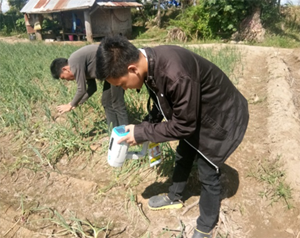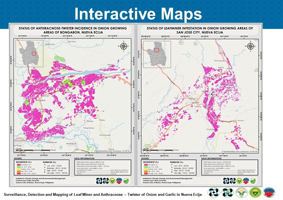 Farmers, local government units of Nueva Ecija, and neighboring onion- and garlic-growing provinces have something to look forward to: to protect their crop and prevent widespread occurrence of pests and diseases. By applying information and communication (ICT) tools and techniques, interventions can be implemented ahead of time, thus preventing huge losses.
Farmers, local government units of Nueva Ecija, and neighboring onion- and garlic-growing provinces have something to look forward to: to protect their crop and prevent widespread occurrence of pests and diseases. By applying information and communication (ICT) tools and techniques, interventions can be implemented ahead of time, thus preventing huge losses.
An ongoing project, “Surveillance, detection, and mapping of leaf miner and anthracnose-twister diseases in onion and garlic,” works on a comprehensive approach to keenly observe, investigate, and map the presence of such diseases in specific sites of the province. The approach includes preventive measures, management strategies, and service centers to assist farmers.
Disease surveillance is being carried out not by human scouting, which is usually inaccurate, expensive and time-consuming. Instead, the project is using computer-based tools and software, remotely sensed data, unmanned aerial vehicle and satellite imageries, spectral signatures of infestations in onions at different phenological stages, meteorological data, and other data from existing reliable providers.
The Central Luzon State University (CLSU) is implementing the project through the funding support of the Department of Science and Technology (DOST) and monitoring mechanism of the DOST-Philippine Council for Agriculture, Aquatic, and Natural Resources Research and Development (DOST-PCAARRD). CLSU is conducting the project in cooperation with the Regional Crop Protection Center of the Department of Agriculture in Region 3.
The project, which started in July 2018, is being conducted through the leadership of CLSU’s Dr. Ronaldo T. Alberto. It is expected to be completed in September 2020. So far, the project has updated topographic base maps of onion and garlic in Nueva Ecija. It has generated maps of leaf miner infestation in onion in Nueva Ecija from December 2018 to January 2019. Reports submitted to PCAARRD show that all municipalities were affected except for Lupao. The highest leaf miner infestation was recorded in Rizal with an area of 185.45 hectares or 14.31% of the 1,295.87 hectares total area planted. The lowest infestation was recorded in the municipalities of Aliaga, Talavera, and Pantabangan.
Likewise, the project has generated initial maps on anthracnose-twister of onion and garlic in selected municipalities of Nueva Ecija.
All the generated map series of leaf miner and anthracnose-twister incidence as of January 2019 were turned over to and discussed with officials of Municipal Agriculture Offices of Nueva Ecija, Regional Crop Protection Center, and other stakeholders. Early detection and mapping of the diseases enabled concerned offices to implement necessary measures to avoid further spread of the diseases.
 Aside from informing local government units of the disease/s, through the map series, Dr. Alberto and his project team have also distributed information, education, and communication materials on Integrated Pest Management of onion, provided advisory services and technical briefing to onion farmers in 12 municipalities.
Aside from informing local government units of the disease/s, through the map series, Dr. Alberto and his project team have also distributed information, education, and communication materials on Integrated Pest Management of onion, provided advisory services and technical briefing to onion farmers in 12 municipalities.
Furthermore, with the project, Dr. Alberto reported reduction in yield losses due to anthracnose-twister and leaf miner ranging from 12 to 34 percent. Without the project, yield losses are higher, ranging from 60 to 80 percent.
Without the project, yield losses in garlic due to Anthracnose-twister is higher or 80 percent compared to only 21 percent with the project.
The project team has designed and developed a webpage, which will house the outputs of the project. At its completion, the project is expected to establish plant hospital, and pest and disease surveillance and research center.
